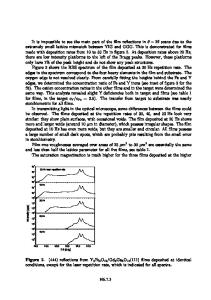Influence of Laser Processing Strategy and Remelting on Surface Structure and Porosity Development during Selective Lase
- PDF / 3,675,676 Bytes
- 12 Pages / 593.972 x 792 pts Page_size
- 59 Downloads / 396 Views
ODUCTION
ADDITIVE manufacturing technologies, such as selective laser melting (SLM) and direct laser deposition (DLD), are increasingly used to fabricate components for various applications due to their excellent near-netshape manufacturing capacity. These technologies show CHUNLEI QIU is with the School of Materials Science and Engineering, Beijing University, Beijing, 100083, P.R. China, and also with the School of Engineering, Cardiff University, The Parade, Cardiff, CF24 3AA, UK. Contact email: [email protected] ZHUO WANG and LEI CHEN are with the Department of Mechanical Engineering, Mississippi State University, Starkville, MS 39762. AIMAN SALIM ALADAWI, MOHAMMED AL KINDI, and ISSA AL HATMI are with the School of Engineering, Cardiff University. HU CHEN is with the Department of Mechanical Engineering, Mississippi State University, and also with the School of Materials Science and Engineering, Tsinghua University, Beijing 100084, P.R. China. Manuscript submitted October 30, 2018.
METALLURGICAL AND MATERIALS TRANSACTIONS A
unique processing characteristics such as layerwise manufacturing, complex laser-material interaction, melting of powder layers and remelting of previous layers, high thermal gradient in melt pools and thus tendency for directional solidification, rapid solidification, and cooling. The first three characteristics greatly influence the inter-layer bonding, surface structure, and porosity development in as-fabricated samples, while the rest show great influence on microstructural development. Given that both defects (such as porosity) and microstructure can greatly affect the mechanical properties of additively manufactured materials, considerable studies have been conducted on additively manufactured metallic materials to minimize defects and optimize microstructure as well as to develop understanding on the formation mechanism of defects and microstructure during SLM and DLD. Regarding the mechanism of formation of pores during SLM, Qiu et al.[1] and King et al.[2,3] first investigated the interaction between a laser heat source and a powder layer through both the modeling
approach and experimental observation and revealed that unstable melt flow plays a major role in the formation of pores in a freshly melted layer and in surface structure development. Unstable melt flow tends to lead to melt splashing and to the development of increased porosity and irregularly shaped surface structure on the newly built layer.[1] The melt flow behavior during SLM was further in situ investigated by Leung et al.[4] and Zhao et al. recently[5] using high speed X-ray imaging. Leung et al. directly observed that the laser-induced gas/vapor jet promotes the formation of melt tracks and denuded zones via spattering. They also demonstrated the pore migration by Marangoni-driven flow and pore dissolution and dispersion by laser remelting. Zhao et al. demonstrated that where local input energy density is too high, the melt pool would become deep and the melt flow so unstable that keyhole pores would be developed. This i
Data Loading...











